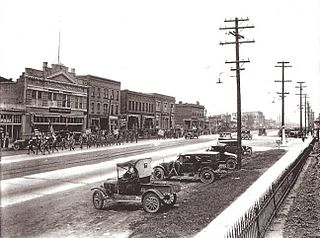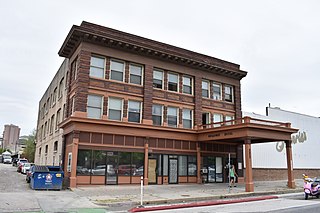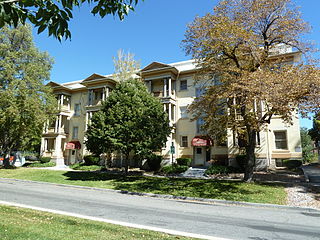
Camp Floyd State Park Museum is a state park in the Cedar Valley in Fairfield, Utah, United States. The park includes a small part of the former Camp Floyd site, the Stagecoach Inn, and the Fairfield District School.
The Avenues is an affluent neighborhood in Salt Lake City, Utah. It is named after the perfectly gridlike, closely laid out roads called Avenues and Streets. First surveyed in the 1850s, the Avenues became Salt Lake City's first neighborhood. Today, the Avenues neighborhood is generally considered younger, more progressive, and somewhat "artsy" when compared to other neighborhoods. Many young professionals choose to live there due to the culture and easy commute to downtown.. It is also one of the most important strongholds of the Utah Democratic Party.

The Murray Downtown Historic District is located in the historic city center of Murray, Salt Lake County, Utah. It was listed on the National Register of Historic Places in 2006, with a boundary increase in 2020.

The Warenski-Duvall Commercial Building and Apartments, built in 1915, is a two-story brick, two part commercial block that is listed in National Register of Historic Places. The building is significant for its role in the early urbanization of Murray, Utah. The Warenski-Duvall building represents a building-type common during the early-twentieth century development of Murray's commercial business district and it is also part of the Murray Downtown Historic District. The building's owner was Edward J. Warenski, an early resident of Murray who owned a saloon and grocery store on State Street. Warenski and his family lived just north of the store. In 1923, the Duvall family purchased the building and divided the upper floor into apartments where family members and other workers in downtown Murray lived.
The Murray Downtown Residential Historic District is the best representative area of the residential settlement and development of the city of Murray, Utah, United States. It was listed on the National Register of Historic Places in 2005. It is locally significant as a physical reflection of its residential architecture and the historic development of the city from its agricultural beginnings through its industrial era and current status as a small suburban city. The buildings within the district represent the wide range of architectural styles and plans popular in the city and the state of Utah between 1870 and 1954 and retain a high degree of integrity.
Ware & Treganza was a leading American architectural firm in the intermountain west during the late 19th and early 20th century. It was a partnership of Walter E. Ware and Alberto O. Treganza and operated in Salt Lake City, Utah.

Silver Row is a historic site located in Provo, Utah. It is listed on the National Register of Historic Places.

The Altadena Apartments in Salt Lake City, Utah, which includes the Altadena Flats and the Sampson Altadena Condominiums, were built in 1905 or 1906 by the Octavius Sampson family at cost of $21,000. The building has Tuscan columns, pediments, and dentillated cornices.

The Armista Apartments, known also as the Waldorf Apartments, at 555 East 100 South in Salt Lake City, Utah, United States were built in 1927. They were listed on the National Register of Historic Places in 1989.

The Broadway Hotel is a historic hotel in Salt Lake City, Utah, United States.
John Charles Craig was an architect in Salt Lake City, Utah.
The University Neighborhood Historic District is a 180 acres (73 ha) historic district near the University of Utah campus in northeastern Salt Lake City, Utah, United States, that was listed on the National Register of Historic Places in 1995.

Cluff Apartments, also known as Bennett Apartments and Hillview Apartments, is a historic building in northeastern Salt Lake City, Utah, United States, that is located within the University Neighborhood Historic District, but is individually listed on the National Register of Historic Places (NRHP).

Ashby Apartments, also known as Gooch Apartments and Suzanne Apartments, is a historic building in Salt Lake City, Utah. It was built in 1925-1926 for the Bowers Investment Company, and designed in the Mission Revival style. It was acquired by the Eflow Investment Company in 1926. From 1936 to 1963, it belonged to Ralph A. Badger, who owned and managed five apartment buildings in Salt Lake City, and who served as the president of the Apartment House Association of Utah. The building has been listed on the National Register of Historic Places since November 16, 2006.

Bigelow Apartments is a historic three-story building in Salt Lake City, Utah. It was built in 1930-1931 by Archelaus Fillingame, and designed in the Exotic Revival style. Fillingame was the developer, architect, builder and owner of the building, which remained in the Fillingame family until 1948. It has been listed on the National Register of Historic Places since December 30, 2004.

Corona Apartments is a historic three-story building in Salt Lake City, Utah. It was built by the Bowers Building Company in 1925, and designed in the Prairie School style. It has been listed on the National Register of Historic Places since October 20, 1989.

Lincoln Arms Apartments is a historic three-story building in Salt Lake City, Utah. It was built in 1924–1925 by Phillip T. Bratt, who owned the building with his wife N. Myrtle Bratt until 1926, when they sold it to Katie R. Stevens. It was later owned by J.B. Arnovitz and James L. White (1931–32), followed by J.H. and Elizabeth Angel. It has been listed on the National Register of Historic Places since October 20, 1989.

Cornell Apartments is a historic three-story building in Salt Lake City, Utah. It was built in 1910 by W.C.A. Vissing, an immigrant from Denmark who became "one of the most active developers of apartment buildings in Salt Lake City during the pre-World War I period". It was designed in the Colonial Revival and Classical Revival styles. Vissing sold the building to Blanche Castleman in 1912, and it belonged to the Bergerman family from 1923 to 1934. It has been listed on the National Register of Historic Places since October 20, 1989.

Smith Apartments is a historic three-story building in Salt Lake City, Utah. It was built as a U-shaped residential building by Andrew and James E. McDonald in 1908, and designed in the Prairie School style by architects Walter E. Ware and Alberto O. Treganza. It belonged to David Smith, a rancher from Idaho, until 1944, when it was acquired by the Riverton Motor Company. It has been listed on the National Register of Historic Places since October 20, 1989.

The Benworth-Chapman Apartments and Chapman Cottages are two apartment buildings in Salt Lake City, Utah. The Benworth-Chapman Apartments building was built as Benworth Apartments by George Bowles & Sons in 1927, and designed in the Mission Revival style. Bowles sold the building to Benjamin L. Farnsworth in 1927, and Farnsworth, his wife Alice and some of their children lived in the building with their tenants. The building belonged to the Zions Bank from 1933 to 1937, when it was acquired by Clarissa G. Chapman, who renamed it Chapman Apartments. Chapman Cottages was built in 1937–1940. It has been listed on the National Register of Historic Places since December 30, 2004.

















